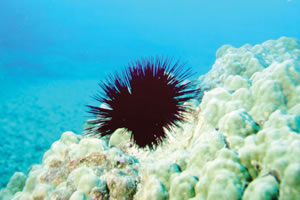Painful Wana Make You Wanna Cry

Wana warning: Don’t tread on me. Photo courtesy UH Sea Grant Program
It penetrates the human skin with relative ease and its wrath is usually felt instantly. Once the piercing pain subsides, it is replaced by constant burning; the slightest pressure on the affected area will send you through the whole process again.
Relief often takes days, sometimes weeks. And to think, all of this because you weren’t paying attention to where you were walking.
Welcome to the world of the venomous sea urchin; better known in the Islands as wana (pronounced vana).
I was recently reintroduced to my old nemesis moments after completing the Queen Liliuokalani Canoe race on the Big Island. After paddling 18 grueling miles in the Kona heat, I jumped out of our koa canoe to cool off my fatigued body. A welcoming crew was there to help carry our vessel out of the ocean. But in my haste to lend a hand, I planted my feet firmly on the reef below: huge mistake!
The shooting pain jolted me and I immediately forgot about the soreness in my back and tightness in my shoulders. I had felt this sensation dozens of times as a teenager after bouncing off reefs at different surf breaks. And, like a child, I let out a loud shriek.
A tutu on shore who was the luna (boss) of the group knew what happened.
“Come here, Ron,” she said in a soft voice. “Let me see if I can pull them out.”
When I lifted my left leg, there they were, a half dozen black barbs projecting out of my big toe and foot. The pain was so intense I actually thought I would see blood. “Get a grip,” I said to myself.
I hopped over to her. She carefully grabbed my foot and gingerly pulled two spines out of my toe. The rest broke at the skin’s surface; their protein toxins already working their magic in me.
“Ron you know what to do next …?” I stopped her before she could finish her sentence knowing what she was about to say. Growing up in Hawaii, we all know what Grandma told us to do when we step on wana. If you don’t know, brace yourself: Find a friend who will urinate on the area to dissolve what’s left. (She obviously didn’t use those words.) That clearly wasn’t an option, so I gave tutu a big hug, thanked her and said I’d be OK. I wasn’t, I was miserable the rest of the afternoon.
Our armored sea urchins are wedged in reefs and coral heads all across Hawaii. Their needle-like spines are not life-threatening, but are venomous. Removing them completely is usually next to impossible because they are brittle and often fracture into smaller pieces.
If you don’t want to use urine, vinegar serves the same purpose. Soaking your foot or hand in hot water also can ease the pain. Although many of us have done it, most doctors will tell you never dig into the skin with a needle or pin to get to the spine. You could contaminate the area and cause an infection.
Some doctors even suggest taking vitamin D to help absorb the spines faster.
After more than a day of suffering (every step I took), I asked my wife to do what we’re not supposed to do. I didn’t want to wait the two to three weeks it would take for the spines to absorb or work though my skin. So she and my daughter went to work with a flashlight, a safety pin and a tweezer.
I grimaced in pain and my daughter Haven jokingly shouted, “Cowboy up, Ronald!” One by one they removed the little spines. After 15 minutes it was over, all that was left were four pukas in my toe and foot.
My wife smiled as I limped away.
“You got too much joy out of that,” I said to her.
She laughed and why wouldn’t she? After all, her Hawaiian name is … Wanalaulani.



